Trade policy: response to UK Government consultation on future free trade agreements
The Scottish Government’s initial response to consultations on the UK’s future trade relationships with Australia, New Zealand, and USA.
Chapter 2: The Four Markets
30. Scotland’s Role in the Development of Future UK Trade Arrangements[8] envisages the involvement of the devolved administrations in future trade policy beginning at a very early stage, with the assessment of the desirability of particular new trade details, and the identification of countries or trading blocs for new agreements. It also envisages a process of assessing the likely impact of any new deals on a sectoral and geographic basis, to ensure that decisions to enter into new arrangements are taken in the knowledge of the possible impact for all parts of the UK.
Choice of Markets[9]
The Importance of the EU Market
31. As we and others have repeatedly argued, leaving the EU, Single Market and Customs Union will cause real and significant issues across the Scottish economy. The EU is the largest single market for Scotland’s international exports, representing 43% of our total international exports, and worth £12.7 billion in 2016. A further
£3.7 billion of exports - accounting for a further 12% of Scotland’s international exports – are to countries with which the EU already has a trade agreement in place.
32. The two largest sectors of Scottish exports to the EU are, by some way, coke, refined petroleum and chemical products and food and drink. The EU is a particularly important destination market for exports from the coke and refined petroleum sector, accounting for more than 80% of Scotland’s international exports in that sector.
33. While there are some similarities, Chart 2 demonstrates there are some significant differences between Scotland and the UK’s export profiles to the EU. Sectors such as beverages (spirits), and fish, crustaceans, molluscs (seafood) for example, are relatively much more important to the Scottish economy than they are to the UK as a whole.
Chart 2: Exports of goods by sector as a share of total EU exports – Scotland and UK (for Scotland’s ten most important sectors by value in 2017)
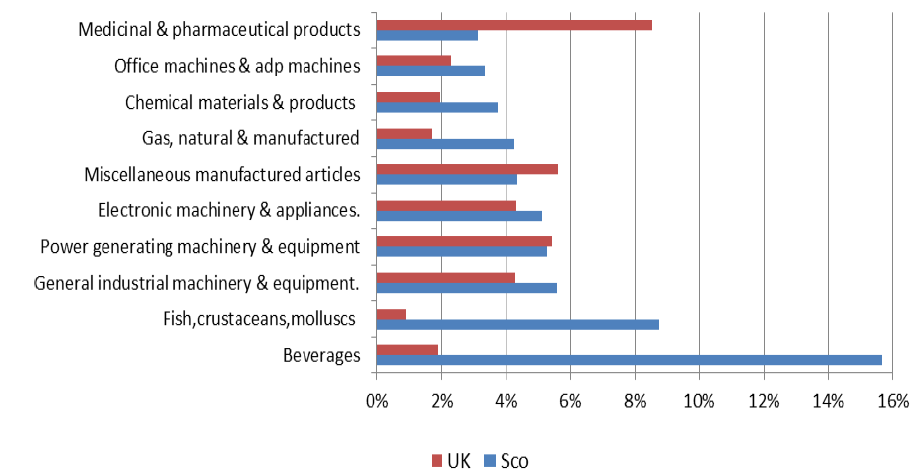
HMRC Regional Trade Statistics
Note – HMRC trade statistics use an alternative methodology based on apportionment of UK data. These statistics include estimates for Petroleum and North Sea related exports, while Export Statistics Scotland does not. Petroleum and related materials have not been included in the chart above.
34. The seafood industry is an important example of a sector where Scotland may have very different considerations from the UK as a whole in trade deals. In 2017, 92,000 tonnes of fresh Atlantic salmon – one of the UK’s top food exports - worth £600 million, was exported from the UK (of which 99% was Scottish). The aquaculture sector directly employs more than 2,000 people and contributes around £220M in gross value added to the Scottish economy, with significant wider impacts across the supply chain (estimated to be around £620M in GVA and 12,000 jobs across the Scottish economy). The EU is a vital market for Scottish seafood products, accounting for 77% of seafood exports in 2017 and, while the UK as a whole is a net importer of fish, Scotland is a net exporter to the EU and the rest of the world. Disadvantageous non-tariff barriers in particular could have a devastating impact on the export of fresh seafood. These differential interests need to be protected in considering future trade agreements, in particular with countries seeking to boost their own domestic market.
35. There are some key differences in our trade in services too. In particular, professional, scientific and technical and real estate services account for a much larger share of Scottish service sector exports to the EU, compared to Great Britain.
36. The evidence clearly demonstrates the importance of the EU market to both Scotland and the UK. The Scottish Government’s view is that we should remain in the EU. If Scotland and the UK leave the EU, we must prioritise the important markets we already have, ideally by remaining in the Single Market and Customs Union.
37. In addition, any work to identify markets and develop trade deals must have the need to preserve our relationship with the EU at its core by, for example, retaining a high level of regulatory alignment with the EU. As illustrated above, that work must also be based on a thorough understanding of differences between the economies and trading profiles of Scotland and the rest of the UK, and how they stand to be affected by potential trade deals. That is why involving the devolved administrations at an early stage – starting with the identification of which markets to prioritise – is crucial.
The four consultations
38. While recognising the important links between the UK and Australia and New Zealand, it is not clear from the consultations why DIT have chosen to prioritise these markets in seeking new trade deals. We note in particular that both the UK and Scotland’s existing trade flows with these two countries are comparatively small - as demonstrated later in this chapter - and that physical distance is likely to prove a limiting factor in any attempts to substantially increase trade levels. Further analysis at a national and regional level should therefore be undertaken to assess the potential for growth in those markets, as well as any potential disadvantages for our domestic producers.
39. In contrast, the USA is already a significant trading partner for both the UK and Scotland. However, the Scottish Government believes that any future negotiation of an agreement with the USA would need to be handled carefully, given public sensitivities over, for example the negotiations on the Transatlantic Trade and Investment Partnership (TTIP) between the EU and USA. In particular, the Scottish Government argued during the course of those negotiations that any potential economic benefits from an agreement with the USA should not come at the expense of vital public services at home. The right of governments to regulate must be protected, and there must be no lowering of standards in relation to human and employment rights and environmental safeguards, or in areas such as food safety, all areas critical to the maintenance of consumer confidence.
40. Four of the eleven members of the CPTPP appear in the top twenty Scottish trading partners, set out in Table 1. We recognise the potential benefits that could arise from membership of such a regional – as opposed to bilateral - trade deal, including the possibility of participation in cross-border Asia-Pacific value chains and the enhancement of trade and investment relations. However, it is difficult to assess the UK Government’s proposal to accede to the Agreement when it has not yet entered into force, and the accession processes and procedures are as yet largely unknown. In particular, we note the terms of the existing agreement may leave little room for renegotiation. Given the UK Government’s stated intention to transition existing and pending EU free trade agreements with Canada, Mexico, Chile, Peru, Japan, Singapore and Vietnam, and the fact that it is suggesting simultaneously negotiating with two other CPTPP members - Australia and New Zealand – it is not clear why priority is being given to beginning CPTPP negotiations now, before the agreement has entered into force.
41. For the reasons set out earlier, and because of the importance of the EU market to Scotland and the UK, domestic standards and regulations must remain in as close alignment with the EU as possible. We note that achieving this could potentially be rendered more complicated by the UK’s prospective negotiations with the EU on the Future Economic Partnership, and the EU’s simultaneous trade negotiations with some of the countries dealt with in these consultations.
42. In general, our initial analysis suggests that new trade deals with the markets proposed would be highly unlikely to deliver a sufficient trade increase to offset the effect of leaving the EU Single Market and Customs Union. In terms of goods, the EU accounts for 49% of Scotland’s exports. In comparison, the combination of Australia, New Zealand, the USA and the CPTPP countries accounts for only 20% of goods exports. The Scottish Government believes that trade with the European Union should be the priority in the UK’s post-Brexit trade policy and negotiating positions with new markets should be informed by this goal.
43. The following Scottish Government analysis demonstrates that, while there are some similarities, there are also some significant differences between Scotland and the rest of the UK in terms of existing trade flows with these markets. These differences need to be recognised and taken into account in any initial selection of potential future trading partners, and throughout the development of a UK wide negotiating position, ahead of any discussions.
Overview
44. The markets consulted on accounted for around 20% of both Scotland’s annual goods exports and imports, averaged over 2015-17.
Chart 3: Scotland export destinations and import sources (2015-17 average)
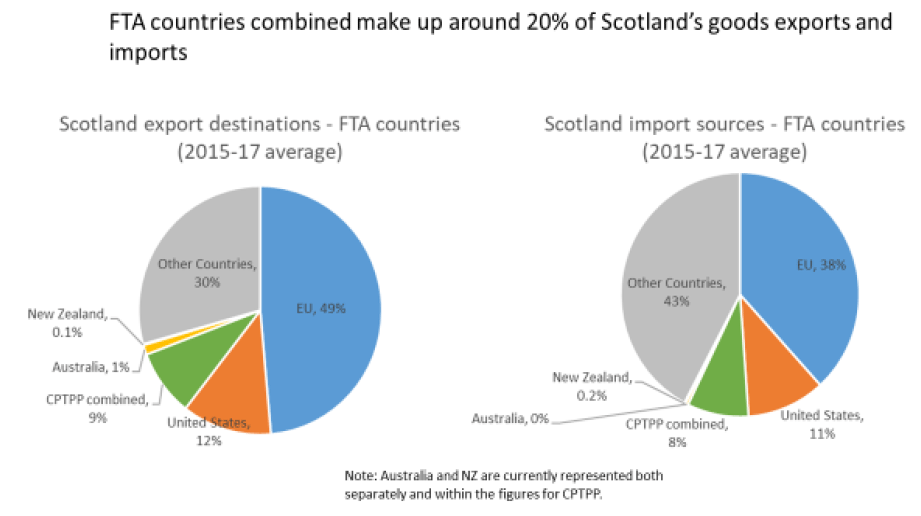
45. Although relatively small compared to Scotland’s exports to the EU and rest of the world, Scotland’s exports to these markets have in general been growing faster than the UK’s exports. Scottish exports to the USA and CPTPP countries in particular have shown growth over the last decade.
Chart 4: Scotland’s goods exports, 2013 to 2017
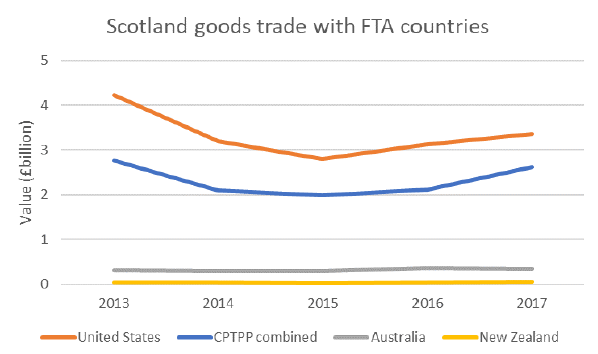
46. Scotland currently has goods trade surpluses with all four of the potential trade agreement markets, while the UK currently has a deficit with New Zealand and CPTPP. However, there are important differences in terms of current sectors of trade between Scotland and the UK as a whole that suggest that Scotland’s interests in these potential agreements may differ from that of the UK.
47. For all four markets, beverages are Scotland’s top export sector, accounting for between 23% and 31% of Scotland’s exports to the relevant countries. For the UK as a whole, beverages represents a significantly less important sector for all four markets. Meanwhile, road vehicles make up a significant proportion of all-UK exports, but are comparatively far less significant for Scotland. This suggests that, when negotiating free trade agreements, Scotland may have very different interests to the rest of the UK. In the circumstances, it is essential that these differences are understood and taken into account as part of the negotiating process, not ignored or sacrificed in order to reach a deal.
48. The markets consulted on made up around 30% of Scotland’s overall services exports in 2016, broadly in line with the UK (and compared to 36% currently to the EU). Of the markets considered, the highest proportion of Scotland’s services exports are to the USA (18%), followed by CPTPP, including Australia and New Zealand (11%) and Australia (4%). There is currently very little trade in services with New Zealand.
Chart 5: Services exports, 2016 – Scotland and UK
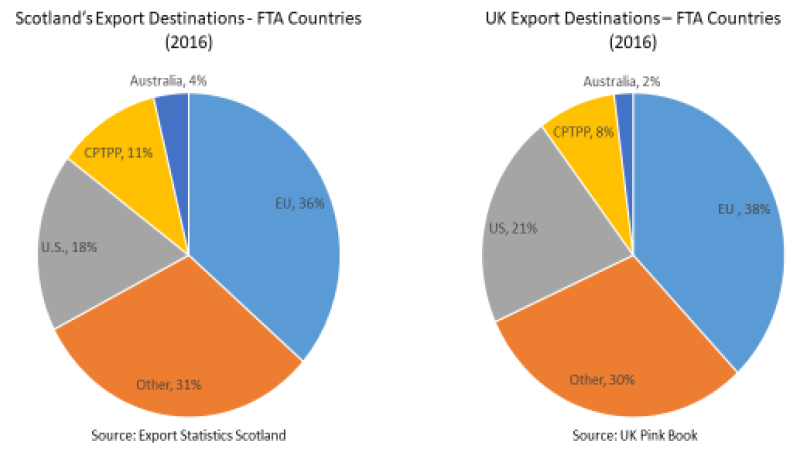
49. The following section considers the UK and Scotland’s existing trade flows with each of the potential markets in greater detail. The differences highlighted are important, in that they illustrate the different sectoral priorities that Scotland and the rest of the UK could have in future trade negotiations.
USA
50. Scotland has a goods surplus with the USA, with exports comprising 11.6% of Scotland’s international exports in 2017 (representing Scotland’s largest existing market among the four considered). While imports from the USA are broadly similar for Scotland and the UK as whole, export patterns differ significantly, with beverages making up a significant portion of Scotland’s exports – 31% - and food, chemicals and related products showing strong growth in recent years. For example, the value of Atlantic salmon exported to the USA is higher than for any other region. Beverages account for only 3% of goods exports to the USA for the UK as a whole. In contrast, medicinal and pharmaceutical products, road vehicles and other manufactured articles are significantly more important exports for the UK as a whole than for Scotland.
Chart 6: Exports of goods to the USA by UK region, 2017
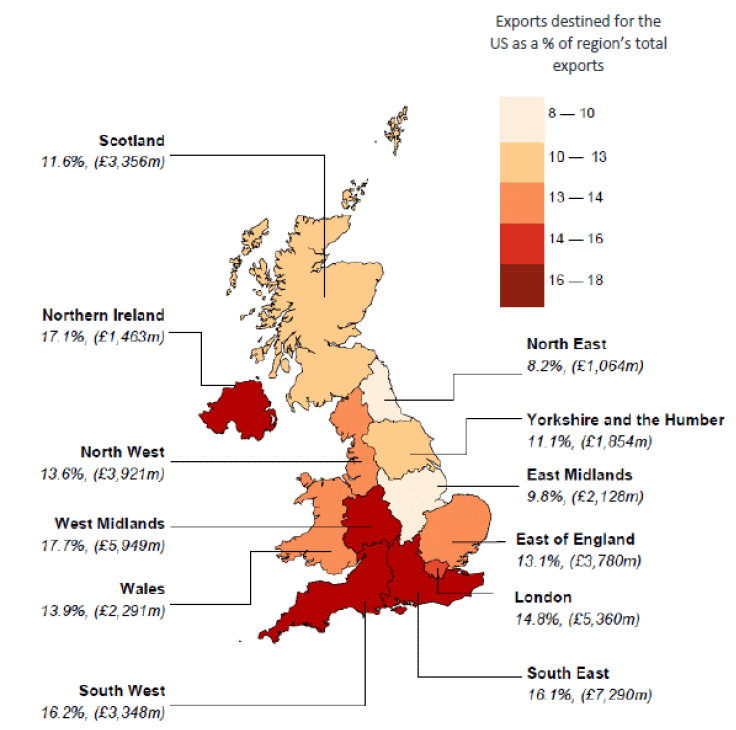
Source: Department for International Trade (2018) Information pack for the consultation relating to a bilateral Free Trade Agreement between the United Kingdom and the United States of America.
51. The USA is already Scotland’s largest single country services trading partner, with Scotland’s services exports to the USA representing 18% of its international service exports in 2016. Scotland’s services exports to USA have grown faster than those of the UK as a whole, at a rate of 7.3% per annum between 2002 and 2016.
52. While service exports to the USA from Scotland and the UK as a whole are dominated by the same sectors - financial services and business/professional services - financial and insurance activities are considerably more important to Scotland, representing 42.8% of exports to the USA, as opposed to 28% for the UK as a whole. Service exports in this area grew by 392% in finance and insurance activities (12% per annum) and by 207% (8.3% per annum) in professional services between 2002 and 2016, driving Scottish growth in services exports to the USA.
Chart 7: Services exports to the USA by sector, 2016 – Scotland and UK
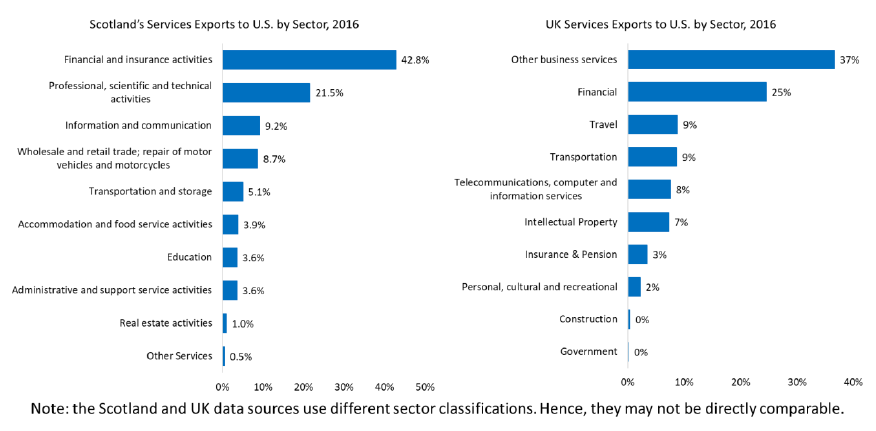
53. In terms of services exports, it is not clear the extent to which a trade agreement with the USA that included services would boost Scottish exports. Barriers to trade in services typically arise from domestic regulation in other countries, and the experience of free trade agreements is that they only tend to reduce some of these barriers. While the USA is already an important market for Scottish and UK services, areas which could potentially be of interest in terms of potential expansion of trade - such as insurance - encounter significant barriers, often at state level. Analysis of the terms of the recently agreed USA-Mexico-Canada Agreement (USMCA) suggest some progress in addressing barriers to trade in services, including in relation to financial services. However, they also suggest that the USA’s preference is for provisions in this areas to remain comparatively narrow in scope. The potential gains therefore remain uncertain.
Australia
54. Reflecting the generally accepted principle in trade economics that economies tend to trade most with their closest neighbours, Australia is generally a relatively small market for economies in the northern hemisphere, with the EU in total only accounting for around 16% of Australia’s goods trade.
55. Australia is an even smaller market for Scotland’s exports, representing around 1% of Scotland’s international goods exports, averaged over 2015-17. However, Scotland exports significantly more goods to Australia than it imports. Once again, the export of beverages is much more important to Scotland than to the UK as a whole, representing Scotland’s most important export to Australia. In light of the strategic importance of Scotch Whisky as an export, in March 2014, the Scotch Whisky Association successfully registered "Scotch Whisky" as a certification trademark in Australia, ensuring a route for protection under Australian national law. Other significant export interests are machinery and transport equipment. Feeding stuff for animals also makes up a much more significant proportion of Scotland’s exports to Australia than for the UK as a whole, with food and chemicals and related products exports to Australia growing substantially over the last decade.
56. The pattern of goods imports from Australia to Scotland is similar to that for the UK as a whole, however Scotland’s imports are more concentrated in a few sectors, including beverages and medicinal and pharmaceutical products.
Chart 8: Scotland’s goods exports and imports with Australia, 2013 to 2017
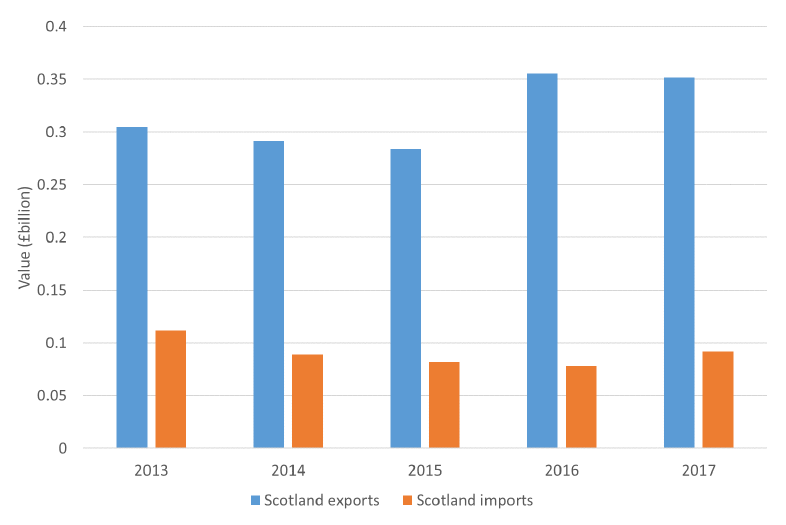
Chart 9: Goods trade with Australia – Scotland and UK
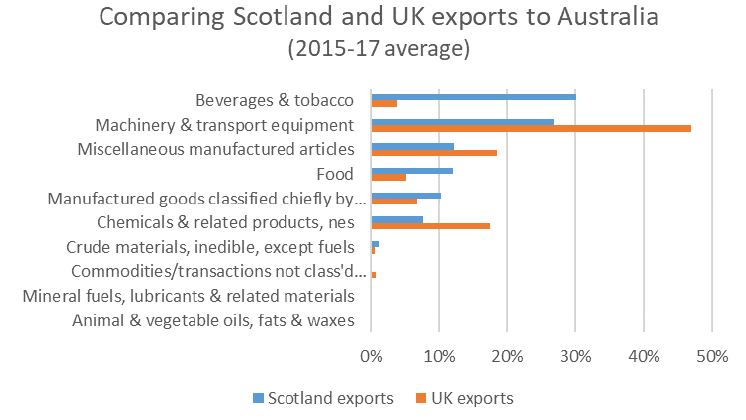
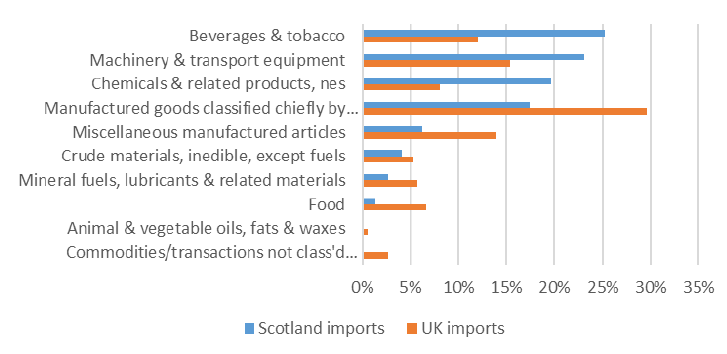
57. While Australia only accounts for 4% of Scotland’s services exports (and just 2% of the UK’s services exports), those exports have grown consistently over time from £105 million in 2002 to £435 million in 2016, representing growth of 314%, or 10.7% per annum.
58. For most of the past 14 years, the UK’s services exports to Australia grew at a faster rate than Scotland’s services exports, although Scotland’s services exports have outpaced UK growth since 2014.
59. In addition, Scotland’s services exports differ significantly from the UK as a whole, with administrative and professional services (34.8% and 26.1% respectively) accounting for the majority of Scotland’s service sector exports to Australia, whereas transportation and travel account for the majority of UK service sector exports (31% and 28%).
Chart 10: Services exports to Australia by sector, 2015 – Scotland and UK
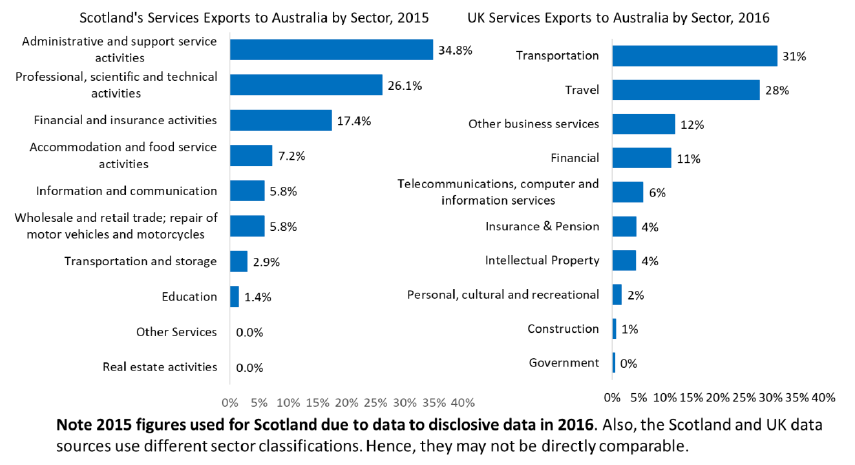
60. Given the modest value of existing trade between Scotland and Australia, and the geographical distance between them, further analysis is required to establish how a trade agreement might boost Scottish trade with Australia.
New Zealand
61. While the UK is New Zealand’s fourth largest source of imports in goods and services, Scotland’s exports to New Zealand are generally very small – around £50m per annum.
62. With the exception of 2015, Scotland exports more goods to New Zealand than it imports. Beverages, other transport equipment, medicinal and pharmaceutical products and power generating machinery and equipment make up a much more significant proportion of Scotland’s exports to New Zealand, than for the UK as a whole. Scotland’s export of chemicals and related products, machinery and transport equipment and food have grown well over the last decade.
63. In terms of goods imports, the food sector is considerably more important to the UK as a whole than it is to Scotland (representing 46% of the UK’s imports from New Zealand, as opposed to 4% of Scotland’s imports).
Chart 11: Scotland’s goods exports and imports with New Zealand, 2013 to 2017
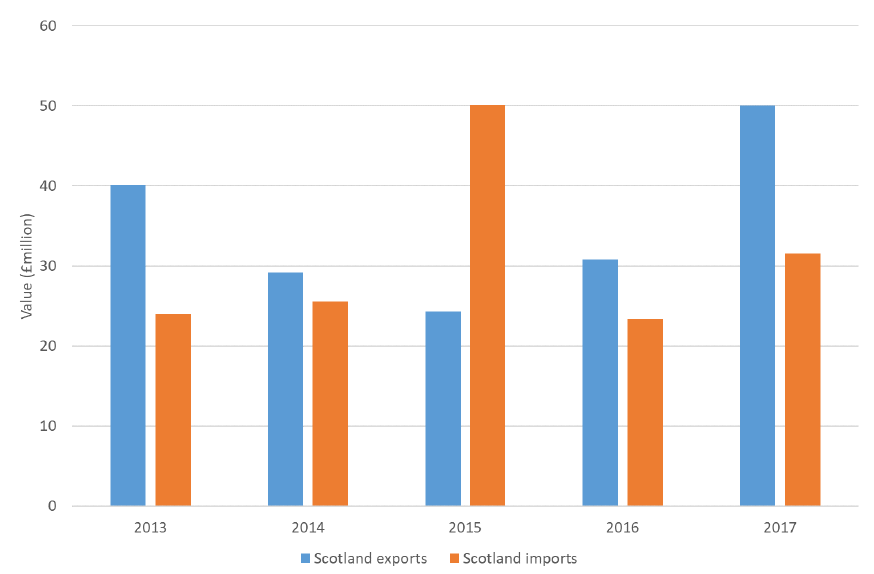
Chart 12: Goods trade with New Zealand (2015-17 average) – Scotland and UK
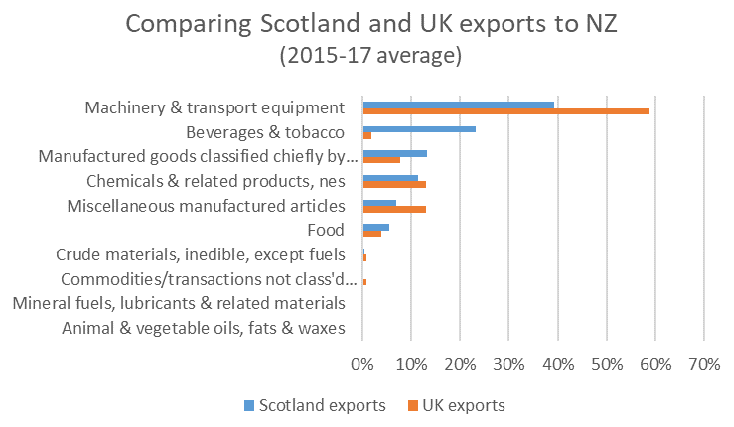
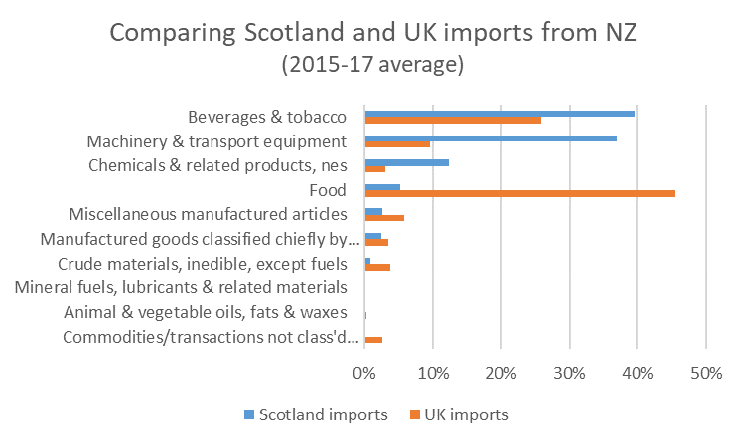
64. Statistics on Scotland’s share of New Zealand’s service markets are not available. However, comparing the UK’s exports to New Zealand with Scotland’s top international exports shows that business services and financial services are the sectors likely to have the greatest potential for Scotland’s services exporters, and we would seek enhanced access to these markets. However, as Scotland’s share of New Zealand’s overall market is relatively small, it may prove difficult to generate additional economic value for our service exporters as a result of a new trade agreement.
CPTPP
65. CPTPP countries (including Australia and New Zealand) represented 9% of Scotland’s international goods exports trade, and 8% of imports, averaged over 2015-17. Again, beverages is a particularly important export industry to CPTPP countries that is not shared with the UK as whole (28% of Scotland’s exports averaged over 2015-2017, as compared to 4% of the UK as a whole). In contrast, road vehicles (14% for the UK, 2% for Scotland) and medicinal and pharmaceutical products (8% for the UK, 2% for Scotland) make up a large share of the UK’s exports, but a small share of Scotland’s. Scotland’s exports of chemicals and related products and food have grown strongly in recent years.
Chart 13: Goods trade with CPTPP countries (2015-17 average) – Scotland and UK
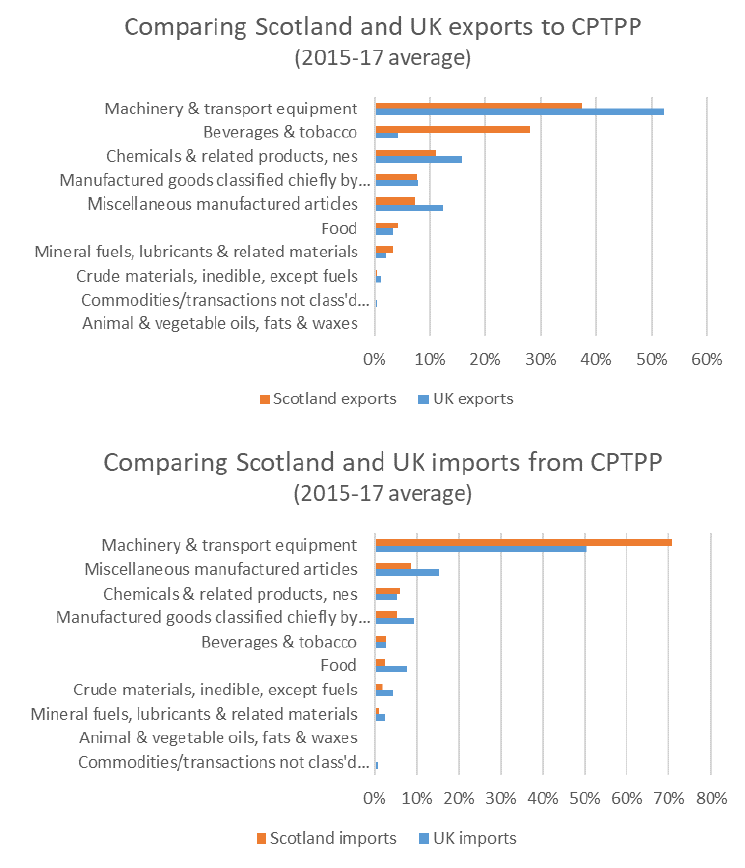
66. In terms of goods imports, other transport equipment and power generating machinery and equipment make up a much more significant proportion of Scotland’s imports from CPTPP countries than the UK as a whole. In contrast, road vehicles and telecoms make up a large proportion of UK imports (18%, averaged over 2015-2017), but only 2% of Scottish imports.
67. CPTPP countries represent 11% of Scotland’s international services exports, 8% for the UK as a whole. Scotland’s total services exports to CPTPP countries - including Australia – have grown consistently over time from £445 million in 2002 to £1,285 million in 2016, representing a growth rate of 189%, or 7.9% per annum. Exports have grown at a similar rate for Scotland and the UK as a whole since 2002. Again, financial services and business/professional services dominate Scotland’s service exports, although the biggest growth per annum since 2002 has been seen in administrative and support service activities, currently the third most important sector in Scotland’s services trade with CPTPP countries, and representing 13.6% of exports.
Chart 14: Services exports to CPTPP countries by sector, 2016 – Scotland and UK
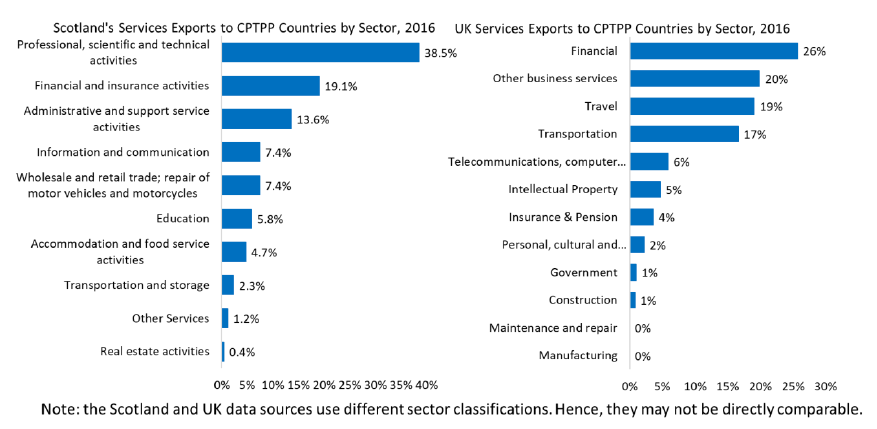
68. Almost two thirds of Scotland’s service exports to CPTPP countries are to Australia and Canada. 90% are shared between Australia, Canada, Japan and Singapore. The remaining 10% is shared between Malaysia, New Zealand, Brunei, Chile, Mexico, Peru and Vietnam.
Table 2: Scotland's Services Exports to CPTPP, by Country, 2016
| Service Exports 2016 (£m) | Proportion of CPTPP Total | |
|---|---|---|
| CPTPP | 1,285 | 100% |
| of which… | ||
| Australia | 435 | 34% |
| Canada | 390 | 30% |
| Japan | 175 | 14% |
| Singapore | 160 | 12% |
| Malaysia | 50 | 4% |
| Other CPTPP | 75 | 6% |
| "Other CPTPP" includes New Zealand, Brunei, Chile, Mexico, Peru and Vietnam | ||
69. CPTPP includes the liberalisation of services, and sets out rules around the number of business days that can be spent in each country, offering certainty for service providers, and enhancing the potential for global value supply chains in the Asia-Pacific region. However, the agreement takes a different approach to the current EU one on issues such as sanitary and phyto-sanitary measures, and provides limited coverage in relation to financial services (a key interest for Scotland and the UK). In addition, for the reasons set out earlier, the relative advantage to the UK of entering into a regional trade arrangement – as opposed to bilateral trade deals with member countries - requires more detailed assessment once the CPTPP has entered into force.
Contact
Email: Stephen Sadler
There is a problem
Thanks for your feedback